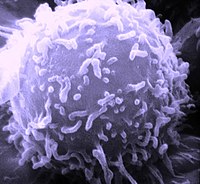
Photo from wikipedia
Acute cellular rejection is a major complication in heart transplantation. We focus on the analysis of new ultrastructural findings in cardiac biopsy rejection based on mitochondrial intracellular organization. This study… Click to show full abstract
Acute cellular rejection is a major complication in heart transplantation. We focus on the analysis of new ultrastructural findings in cardiac biopsy rejection based on mitochondrial intracellular organization. This study includes heart transplanted patients from a single center who were referred for endomyocardial biopsies as a scheduled routine screening. Participants were divided into two groups: patients transplanted without allograft rejection (Grade 0R), and patients with biopsy-proven allograft rejection (Grade ≥ 2R). Using electronic microscopy, we detected a significant increase in the volume density of mitochondria (p < 0.0001) and dense bodies (p < 0.01) in the rejection group. The most relevant finding was the presence of local accumulations of mitochondria close to the nuclear envelope, pressing and molding the morphology of this membrane in all rejection samples (100%). We identified this perinuclear clustering of mitochondria phenomenon in a 68 ± 27% of the total cardiac nucleus observed from rejection samples. We did not observe this phenomenon in any non-rejection samples, reflecting excellent sensitivity and specificity. We have identified a specific phenomenon affecting the architecture of the nuclear membrane—perinuclear clustering of mitochondria—in endomyocardial biopsies from patients with cardiac rejection. This ultrastructural approach might complement and improve the diagnosis of rejection.
Journal Title: Journal of Personalized Medicine
Year Published: 2022
Link to full text (if available)
Share on Social Media: Sign Up to like & get
recommendations!